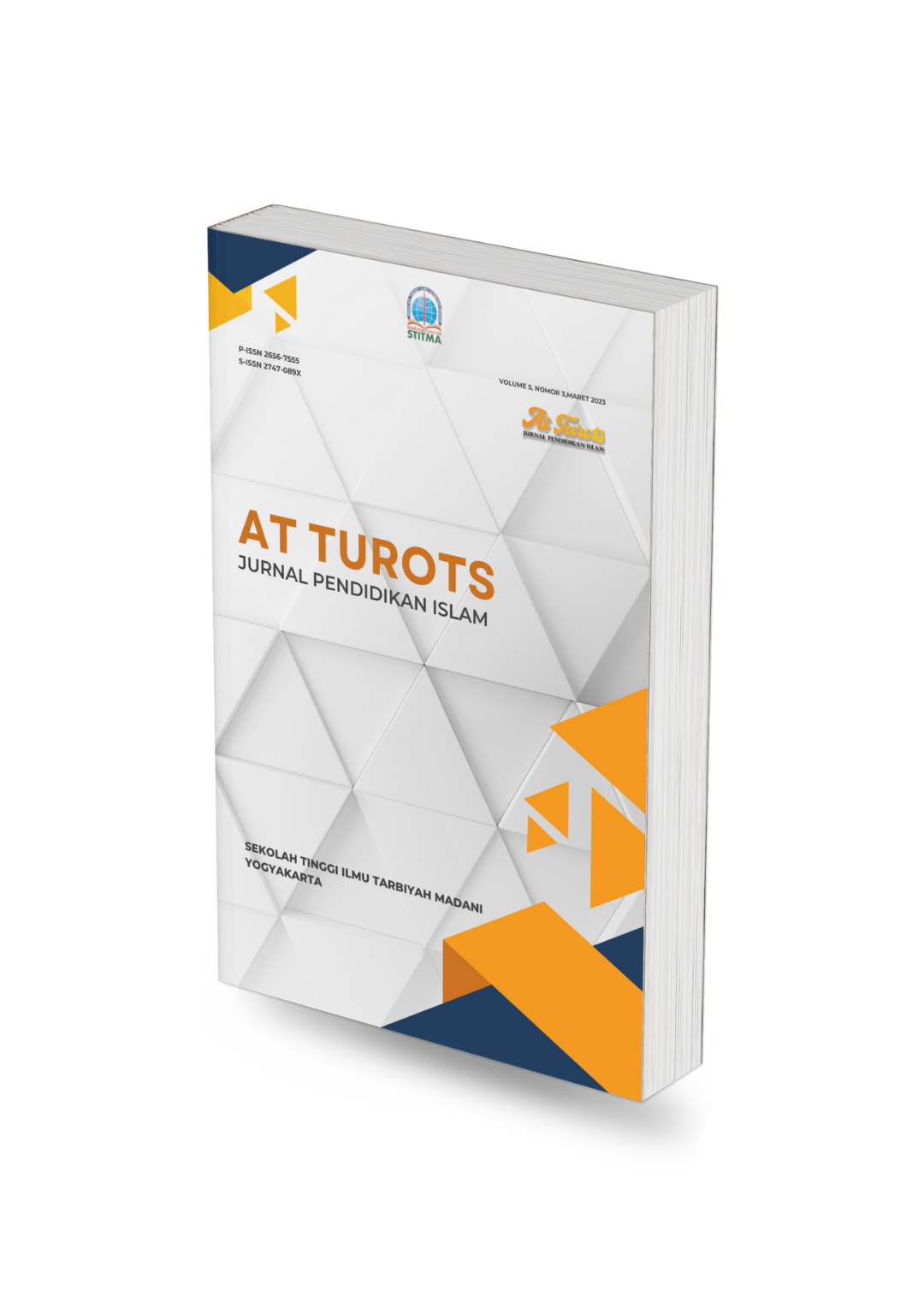Improving islamic religious education learning outcomes through interactive digital media wordwall
DOI:
https://doi.org/10.51468/jpi.v7i1.1048Keywords:
Islamic Religious Education, Wordwall, rural learning, gamification, digital constructivismAbstract
This study aims to enhance Islamic Religious Education (IRE) learning outcomes through the use of the interactive digital medium Wordwall in a fourth-grade class at SDN Bulansari, Subang Regency, a rural school with limited technological infrastructure. A mixed-method quasi-experimental design with pre-test and post-test control groups was employed, involving 60 purposively selected fourth-grade students. Data were collected through standardized cognitive assessments, classroom observations, interviews, and focus group discussions. Quantitative data were analyzed using paired sample t-tests in SPSS, while qualitative data were examined through thematic analysis with NVivo. The findings reveal a significant improvement in the mean cognitive IRE score, from 65 (pre-test) to 82 (post-test) (p < 0.05), alongside an 85% affective engagement rate in moral values discussions. A key observation highlights Wordwall’s capacity to accelerate students’ digital literacy and reinforce the internalization of Islamic values, even within infrastructural constraints. The study concludes that Wordwall is an effective tool for improving both cognitive and character-based learning outcomes, with potential to bridge the digital divide and support
References
Adzibah, S. I., Mardiah, D., & Gasmi, N. M. (2025). Integrating Wordwall in Islamic Religious Education: A Phenomenological Study of Pedagogical Transformation in Indonesian Primary Schools. HEUTAGOGIA: Journal of Islamic Education , 5(1), 19–29. https://doi.org/10.14421/HJIE.2025.51-02
Andrian, A., & Andrian, A. (2024). Anti-Corruption Education Learning Application. Kne Engineering. https://doi.org/10.18502/keg.v6i1.15359
Antropologi, J. P., Diah, T., Putri, A., Wahyudi, R., Sabrina, C., Nabila, M. P., Anwar, M., Lubis, A., & Yusnaldi, E. (2024). Penerapan Media Pembelajaran Gamification Berbasis World Wall Terhadap Motivasi Belajar Siswa Pada Pembelajaran IPS. Buddayah: Jurnal Pendidikan Antropologi, 6(1), 52–56. https://doi.org/10.24114/BDH.V6I1.58900
Asmara, A., Judijanto, L., Hita, I. P. A. D., & Saddhono, K. (2023). Media Pembelajaran Berbasis Teknologi: Apakah Memiliki Pengaruh Terhadap Peningkatan Kreativitas Pada Anak Usia Dini? Jurnal Obsesi Jurnal Pendidikan Anak Usia Dini, 7(6), 7253–7261. https://doi.org/10.31004/obsesi.v7i6.5728
Creswell, J. W., & Plano Clark, V. L. (2011). Designing and Conducting Mixed Methods Research (2, Ed.). SAGE Publications.
Fathurrahman, A., Sumardi, S., Yusuf, A. E., & Harijanto, S. (2019). PENINGKATAN EFEKTIVTAS PEMBELAJARAN MELALUI PENINGKATAN KOMPETENSI PEDAGOGIK DAN TEAMWORK. JURNAL MANAJEMEN PENDIDIKAN, 7(2), 843–850. https://doi.org/10.33751/JMP.V7I2.1334
Fraenkel, J. R., Wallen, N. E., & Hyun, H. H. (2012). Casual-Comparative Research. In How to Design and Evaluate Research in Education. www.mhhe.com/fraenkel8e
Geisler, M. C., Bona, R. J., & Galarça, S. L. da S. (2024). Enhancing Basic Education Through Transmedia: Using Media for Teaching in Blumenau/SC-Brazil. https://doi.org/10.56238/sevened2024.015-003
Ghory, S., & Ghafory, H. (2021). The Impact of Modern Technology in the Teaching and Learning Process. International Journal of Innovative Research and Scientific Studies, 4(3), 168–173. https://doi.org/10.53894/ijirss.v4i3.73
Goncalves, G., Oliveira, T., & Cruz‐Jesus, F. (2018). Understanding Individual-Level Digital Divide: Evidence of an African Country. Computers in Human Behavior, 87, 276–291. https://doi.org/10.1016/j.chb.2018.05.039
Hakim, S., & Setiawan, D. (2024). Analysis of the Use of Educational Game Media for Science Subjects on Digestive System Material. Jurnal Penelitian Pendidikan Ipa, 10(10), 7192–7198. https://doi.org/10.29303/jppipa.v10i10.7392
Haqih, M. K., Hakim, Z. R., & Pribadi, R. A. (2022). Pengembangan Multimedia Interaktif Berbasis Software Articulate Storyline Pada Kegiatan Pembelajaran Tematik. Jurnal Pendidikan Dasar, 10(1), 33–44. https://doi.org/10.46368/jpd.v10i1.473
Hardeliska, T. Y., & Landong, A. (2023). Penerapan Media Pembelajaran Gamifikasi Wordwall Terhadap Hasil Belajar Pada Tema Benda Hewan dan Tanaman Kelas 1 SD Negeri 101911 Sidodadi Batu 8 Deli Serdang. Jurnal Dirosah Islamiyah, 5(3), 879–886. https://doi.org/10.47467/JDI.V5I3.4343
Julia, M. A., Fitriani, N., & Setiawan, R. (2024). Proses Pembelajaran Konstruktivisme yang Bersifat Generatif di Sekolah Dasar. Jurnal Pendidikan Guru Sekolah Dasar, 1(3), 7. https://doi.org/10.47134/PGSD.V1I3.519
Kodrle, S., & Savchenko, A. A. (2021). Digital Educational Media in Foreign Language Teaching and Learning. E3s Web of Conferences, 273, 12018. https://doi.org/10.1051/e3sconf/202127312018
Mayer, R. E. (2009). Multimedia learning, second edition. Multimedia Learning, Second Edition, 1–304. https://doi.org/10.1017/CBO9780511811678
Mursyida, L., Ranuharja, F., Dewi, I. I. P., Samala, A. D., Fikri, R., Sandra, R. P., & Efrizon, E. (2023). Enhancing Teachers’ Proficiency in Implementing Augmented Reality Technology as Interactive Learning Media. Consen Indonesian Journal of Community Services and Engagement, 3(2), 70–77. https://doi.org/10.57152/consen.v3i2.944
Olanrewaju, G. S., Adebayo, S. B., Omotosho, A. Y., & Olajide, C. F. (2021). Left Behind? The Effects of Digital Gaps on E-Learning in Rural Secondary Schools and Remote Communities Across Nigeria During the COVID19 Pandemic. International Journal of Educational Research Open, 2, 100092. https://doi.org/10.1016/j.ijedro.2021.100092
Pantić, N., & Florian, L. (2015). Developing Teachers as Agents of Inclusion and Social Justice. Education Inquiry, 6(3), 27311. https://doi.org/10.3402/edui.v6.27311
Rachmadtullah, R., Setiawan, B., Wasesa, A. J. A., & Wicaksono, J. W. (2022). Elementary School Teachers’ Perceptions of the Potential of Metaverse Technology as a Transformation of Interactive Learning Media in Indonesia. International Journal of Innovative Research and Scientific Studies, 6(1), 128–136. https://doi.org/10.53894/ijirss.v6i1.1119
Rannikmäe, M., Holbrook, J., & Soobard, R. (2025). Social Constructivism—Jerome Bruner. 255–273. https://doi.org/10.1007/978-3-031-81351-1_15
Ryan, R. M., & Deci, E. L. (2023). Self-Determination Theory. Encyclopedia of Quality of Life and Well-Being Research, 6229–6235. https://doi.org/10.1007/978-3-031-17299-1_2630
Sugiyono. (2019). Metode Penelitian Pendidikan: Pendekatan Kuantitatif, Kualitatif, dan R&D. Alfabeta.
Suryanto, S., & Dewi, A. K. (2023). Optimizing PPKn Formative Test in Elementary School Level With Digital Food Education Game. Journal of Intelligent Software Systems, 2(2), 7. https://doi.org/10.26798/jiss.v2i2.1140
Susanto, H., Marpuah, S., Sudarmadi, Erwahyudin, D. D., & Wahyuni, N. (2024). The Development of Interactive Learning Media for Islamic Religious Education in Elementary Schools in Indonesia. J. Res. Math. Sci. Technol. Educ., 1(2), 77–83. https://doi.org/10.70232/jrmste.v1i2.14
Tuwoso, T., Putra, A. B. N. R., & Muhammad, A. K. (2021). The Innovation of Augmented Reality Learning Media With Interactive Component Model to Improve Special Ability of Vocational Education Knowledge in the Digital Era. International Journal of Interactive Mobile Technologies (Ijim), 15(21), 188. https://doi.org/10.3991/ijim.v15i21.24833
Vygotskiĭ, L. S., & Cole, M. (1978). Mind in society: the development of higher psychological processes. Harvard University Press.
Yersel, B., Kalkan, B., Er, F., Özer, A., & KORUL, A. U. (2023). Digital Divide and Emergency Remote Education: Reconsidering the Use of Educational Radio During the Pandemic. Turkish Online Journal of Distance Education, 24(4), 238–256. https://doi.org/10.17718/tojde.1101847
















